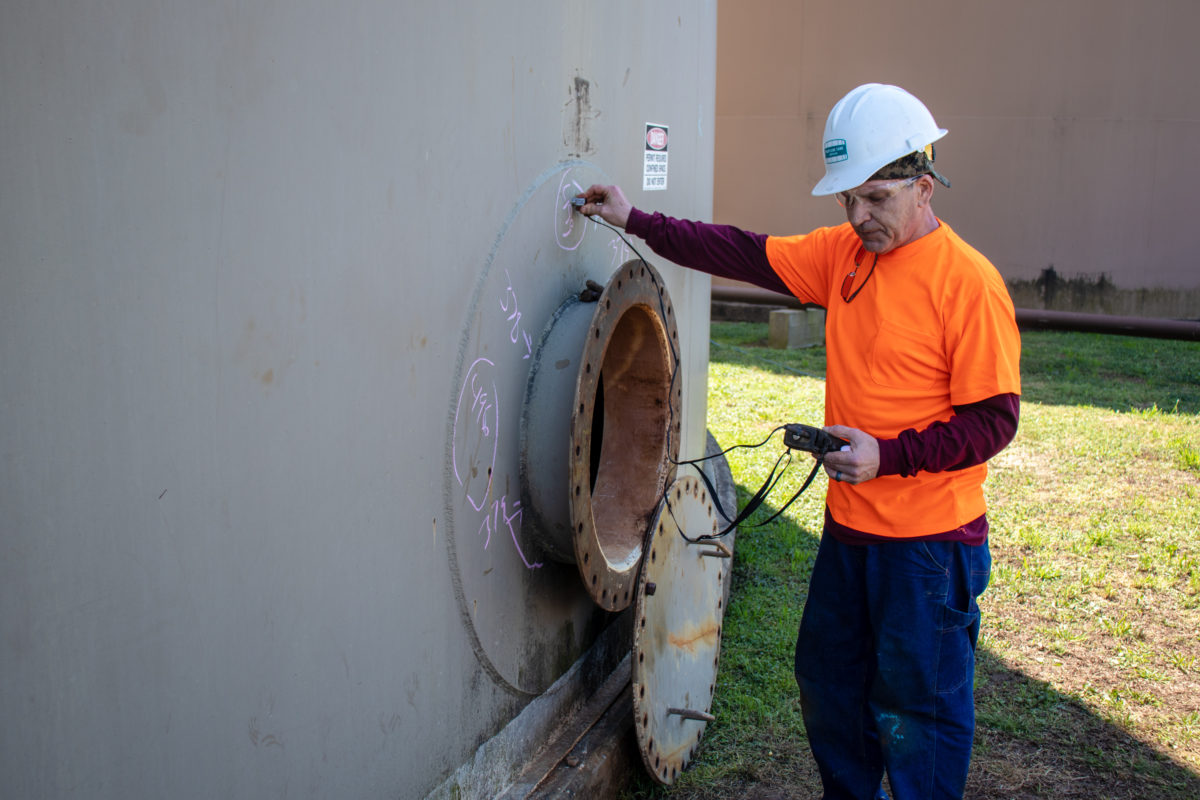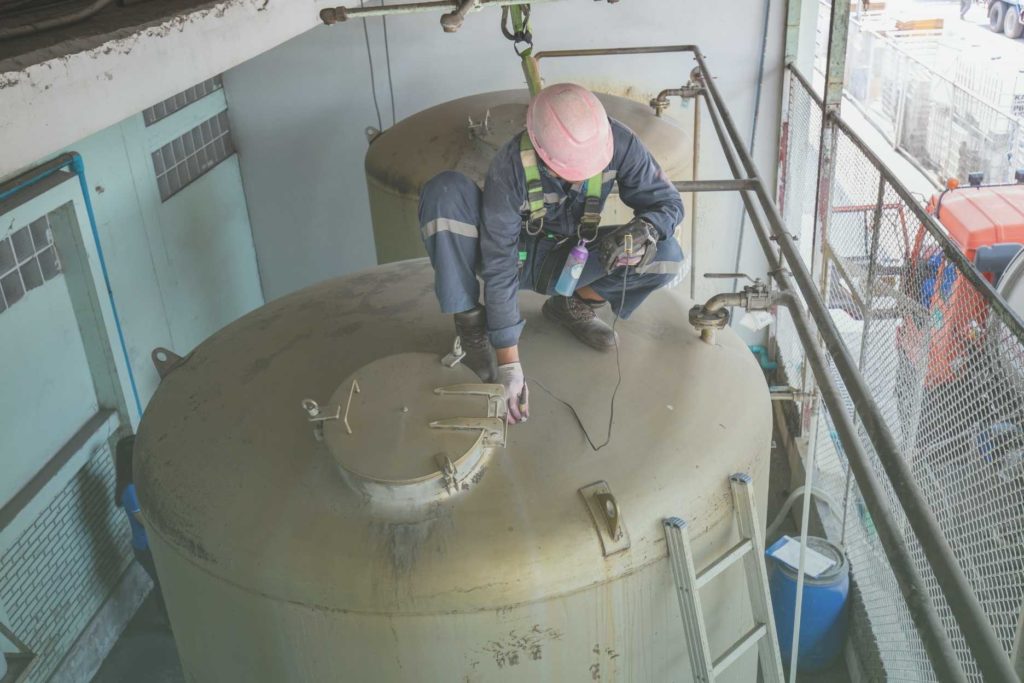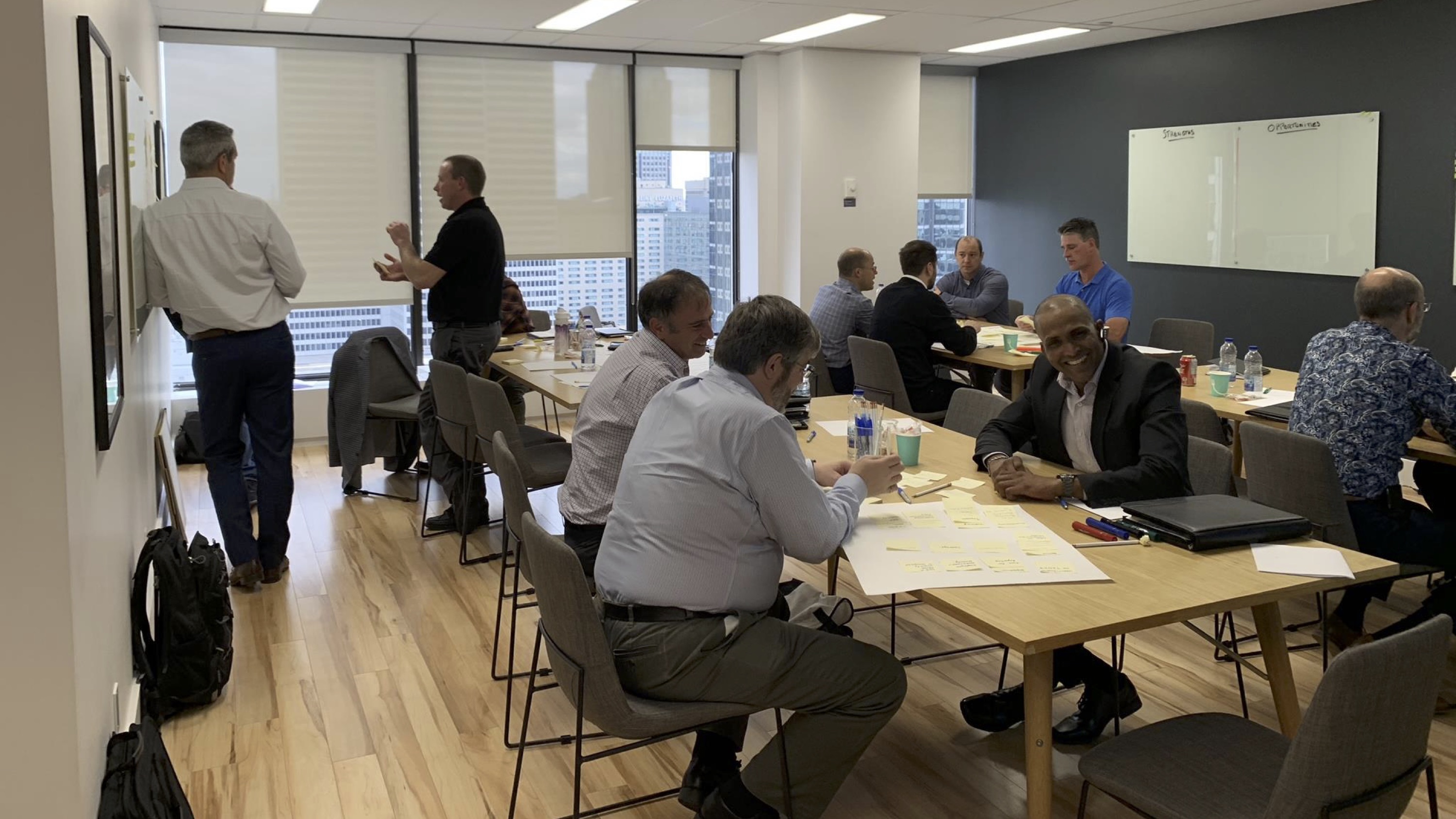Supply chain
When Seven Departments Won't Talk: A UX Strategy Story
Overview
When I joined Canadian National Railway (CN) as Lead Product Designer, a key strategic project with huge environmental impact had been stuck for six months. Not stuck because of technical complexity or lack of resources. Stuck because seven department directors couldn't agree on who should own it.
CN is a 25,000-employee freight railway company that moves everything—automobiles, coal, lumber, grain, chemicals—across 36000 kilometers of track from Canada to the Gulf of Mexico. When you're transporting hazardous chemicals you often have to store it first in tanks in the rail yards for a set period of time before loading in tank cars. During that storage time, any leak can trigger an environmental catastrophe. That's why specialized inspectors travel constantly across the network, checking every tank sitting in CN's yards for structural integrity.

Problem Statement
The Brief
This project was born from a new US environmental regulation that just mandated that tank inspections happen four times a year instead of once. And the clock was ticking—the regulation would be enforced in just a few months. CN faced a choice: hire four times more inspectors (millions of dollars in salaries, constant travel, accommodation across the continent) or leverage existing workforce.
Their strategy: leverage existing yard workers—mechanics, carpenters, welders already on-site—and equip them with technology to perform some inspection tasks. The IT department had already decided the solution: a mobile app. My job, as they saw it, was to design that app.
The Real Problem
But when I started digging, I discovered something else entirely. Seven departments had spent six months passing this project around like a hot potato. Transportation Operations said it belonged to Maintenance. Maintenance pointed to Environment. Environment went silent. And the project stayed frozen.
The app wasn't the problem. Getting seven departments to actually talk to each other was.
They communicated only through passive-aggressive email chains, systematically deflecting ownership. And they had been doing this for six months—while the regulatory deadline crept closer. What started as a reasonable timeline had become a crisis. The regulation would be enforced in a few months, and CN still had no plan, no budget, no alignment, and no solution. Nobody could agree on priorities or even what problem they were solving. Operations worried about disrupting service schedules. Maintenance saw a logistical nightmare implementing and training the workforce in just months. Engineering demanded regulatory compliance without liability exposure. Safety refused to risk untrained workers performing hazmat inspections. Compliance felt the pressure of looming deadlines and penalties. Environment was skeptical that non-experts could maintain quality standards. And IT had already decided the mobile app was the solution—before understanding the operational, safety, or quality challenges it needed to address.
The strategic pivot: The problem wasn't the app. It was organizational paralysis. No amount of brilliant UX design would matter if stakeholders couldn't align on a shared vision. Without alignment, there would be no budget, no project, no access to the end users whose workflows we needed to understand.
The question shifted from "How do we design an inspection app?" to "How do we get these seven departments to work together for the first time?"
Stakeholders & Users
The Stakeholders: My Real Challenge
The seven directors weren't just stakeholders—they were the primary problem I needed to solve. Each had legitimate but competing priorities, and they operated in complete isolation:
- Geographically dispersed across different CN facilities
- History of failed cross-functional initiatives
- Organizational culture of silos
- No shared framework for collaboration
- Email as a weapon for deflecting responsibility
My challenge: Transform seven isolated directors into a collaborative team—without any formal authority to do so—before IT pushed forward with a solution that might not address real operational, safety, and quality concerns.
The End Users
Existing yard workers (mechanics, carpenters, welders...) who would be asked to take on inspection responsibilities for the first time, with no prior training in tank inspection or hazmat protocols.
Current inspectors (within the Environment department) who were trained professionals, with natural tension about "diluting" their expertise.
Understanding their workflows was critical, but I couldn't access them yet. Getting into the yards required approval from multiple departments. As long as stakeholders were misaligned, that access was blocked.

Scope & Constraints
No Budget - Not for research, workshops, or even a meeting room. Every expense required justification.
Minimal Team - Just three people: a PM, a BA and myself.
Six Months of Paralysis - Fatigue, skepticism, and toxic email chains. I needed to show progress quickly.
Unprecedented Designer Involvement - CN had never brought a designer into project scoping before. The typical pattern until then was:
Business defines requirements → IT builds → Design polishes UI.
My presence raised eyebrows.
Geographic & Cultural Barriers - Stakeholders spread across the network. Traditional industry, not accustomed to design thinking.
One Shot - Given budget constraints and skepteholder skepticism, I had one chance to prove this approach could work.
Process & What I Did
First Attempt: The Classic Approach (And Why It Failed)
I started with textbook UX research: one-on-one stakeholder interviews to understand needs, constraints, and perspectives.
The response was underwhelming. Some claimed they were too busy and pushed me to junior staff who knew nothing about the project. Others ghosted my emails entirely, even after multiple follow-ups. I eventually managed to speak with only 2 out of 7 directors.
The realization: The email deflection game had become their default mode. Individual interviews would never break through organizational silos. I needed a completely different approach.
The Pivot: Co-Creation Workshop
I decided to bring all seven directors into one room for a full-day co-creation workshop.
Why this approach:
- Force direct communication—no hiding behind email
- Create neutral space outside normal hierarchies
- Use design activities as a common language
- Shift from "me collecting information" to "us building together"
- Make the problem visible in real-time
The logistical nightmare:
Challenge 1: Convincing them to participate
My pitch: "Give me one day to unblock six months of paralysis. If it doesn't work, you've lost a day. If it works, we can finally move forward."
Challenge 2: Securing a co-creation space with no budget.
I had zero budget but needed a proper collaborative space. CN only had traditional, sterile meeting rooms with no whiteboards or workshop materials. After persistent lobbying, I convinced leadership to approve a room for one day
Challenge 3: Finding a date
Coordinating seven executive calendars was hard enough. But we also needed to fly and accommodate around 12 people to Montreal from across the network—Toronto, Halifax, Vancouver, even Florida. After weeks of scheduling gymnastics, we finally locked in one full day.
Preparation (Two Intensive Weeks):
With the PM and the BA, we immersed ourselves in facilitation methodology—Gamestorming and workshop design. I adapted activities for a corporate railroad context, prepared materials, planned timing down to the minute, and conducted individual pre-briefs with each participant. I also studied tank car inspection regulations, hazmat protocols, and yard operations to speak their language.

The Workshop: The Day That Changed Everything
Morning: Breaking Down Silos
We started with collaborative process mapping. Each director explained their department's role: the number of workers in their yards, their daily tasks, the physical layout of the facilities. Some yards had tanks close together; others stretched across vast distances—and CN's rail yards are enormous. As they mapped their pieces on the wall, something clicked. Everyone started to see that adding inspection tasks—even with technology—would fundamentally impact workers' routines, wellbeing, and responsibilities in ways they hadn't considered.
Wait, so that's what happens after we do our part?
I had no idea you were dealing with that constraint.
If we'd known that six months ago, we could have...
The interdependencies became visible. The complexity became shared. The problem stopped being "their problem" and started becoming "our problem."
Next, we identified pain points. As post-its filled the wall, patterns emerged. Many pain points were shared across departments. The Environment department's concern about quality? Operations shared it. Safety's concern about liability? Maintenance felt it too.
The energy in the room shifted. Defensiveness softened into curiosity.
Afternoon: Building Together
Using Gamestorming techniques, I facilitated co-design sessions. But I deliberately steered the focus away from technical solutions and toward workflows. My assumption: the perfect solution wouldn't be just a mobile app—it would be a reimagined process. I divided them into mixed cross-functional groups. The directors—who had spent six months deflecting via email—were now building on each other's ideas in real-time. They mapped out optimized workflows and generated innovative solutions: QR codes for quick tank identification, even drones to speed up visual inspections in hard-to-reach areas of massive yards.
We used dot voting to prioritize collectively. Consensus emerged naturally. The "mobile app" was still part of the solution—but now it was one piece of a much larger operational redesign.
By the end of the afternoon, we didn't have a finalized solution yet—but something more valuable had emerged. Everyone was engaged. The same directors who had shut us down weeks earlier citing "safety concerns" or "organizational issues" were now inviting us to visit their yards. They promised access to workers that had been impossible just weeks before. The doors that had been closed were suddenly opening.

After the Workshop: The Cascade Effect
Immediate Results (Week 1):
The stakeholders kept talking. They scheduled follow-up meetings—without me prompting them. The Environment director emailed: "I don't know what you did in that room, but we actually have a path forward now."
Access Unlocked:
Within two weeks, I received approval to visit yards and conduct contextual inquiry. I spent time in the field across multiple yards, observing workflows, shadowing inspectors, talking to mechanics.
The operational reality was messy, manual, and far more complex than any stakeholder had described. Winter conditions, equipment limitations, time pressures, safety hazards—the yard environment was harsh. Any solution needed to work in that reality.
Building the Roadmap:
- Phased training program (Environment + Safety + Maintenance collaboration)
- Mobile app with offline capability (for yards with poor connectivity)
- Certification process for yard workers
- Audit protocols for quality verification
- Pilot program before network-wide rollout
Three weeks after the workshop, we presented to executive leadership. Budget approved. Project greenlit. Seven departments aligned.
Outcomes & Impact
Immediate Outcomes
Project Unblocked: Six months of paralysis → active development in three weeks
Stakeholder Alignment: Seven departments now had regular cross-functional meetings. Collaboration became the norm.
User Access Granted: First round of field research completed across multiple yards. Solutions grounded in operational reality, not IT assumptions.
The Solution Evolved Beyond the App: Instead of a generic mobile app, we developed a comprehensive operational redesign. The app became one piece—designed around actual yard workflows, with offline capability, QR code integration, and built-in quality controls.
Strategic Impact
Design's Role Redefined: This was CN's first experience with a designer in the scoping phase. It demonstrated that design isn't just about making things look good—it's a strategic tool for organizational alignment.
New Methodology: The workshop approach became a template. Other teams at CN requested similar facilitation. Design thinking started seeping into the organizational culture.
Business Impact: One day of facilitation unlocked a multi-million dollar project:
- Avoided hiring 4x more inspectors (massive savings in salaries, travel, accommodation)
- Prevented potential regulatory penalties
- Reduced environmental risk
- Leveraged existing workforce more effectively
More importantly, it prevented a failed implementation. If IT had pushed forward without stakeholder buy-in or user research, the app would likely have been rejected, wasting significant investment.
Key Lessons
1. The Real Problem Isn't Always the Stated Problem
I was asked to design a mobile app. The real problem was organizational dysfunction. Strategic diagnosis before solution-building is critical.
2. Sometimes, the Designer Must Be a Facilitator
My job wasn't to design an interface—it was to create conditions for collaboration. The most valuable design work had nothing to do with pixels.
3. Small, Well-Designed Interventions Can Create Momentum
One well-executed day changed the trajectory. The workshop was low-cost, low-risk, high-impact.
4. Methodology Must Adapt to Context
Classic user research failed here. There's no one-size-fits-all approach. Understanding organizational dynamics was as important as understanding user needs.
5. Design Impact Goes Beyond Products
Design can solve organizational problems, align stakeholders, and enable change. The workshop didn't produce a prototype—it produced alignment, trust, and a shared vision.
6. Technology Is Not The Solution—It's An Enabler
IT had decided "we need a mobile app" before understanding the problem. The app became part of a larger solution including training, processes, quality controls, and organizational change. UX strategy is about understanding the full system, not just the interface.
Final Reflection
This project fundamentally changed how I think about the role of a designer.
Sometimes, the most valuable thing a designer can do is get people in a room, give them a shared language, and facilitate the hard conversations no one else wants to have.
I was just a designer from IT. But I had tools they didn't: empathy, systems thinking, facilitation skills, and the ability to make the invisible visible. I could see the patterns in their dysfunction. I could design an experience that would break those patterns.
UX strategy isn't just about making good design decisions. It's about creating the organizational conditions for good design to exist in the first place.
This project took place during my time as Lead Product Designer at Canadian National Railway. Names and some details have been adjusted for confidentiality, but the story and lessons are real.